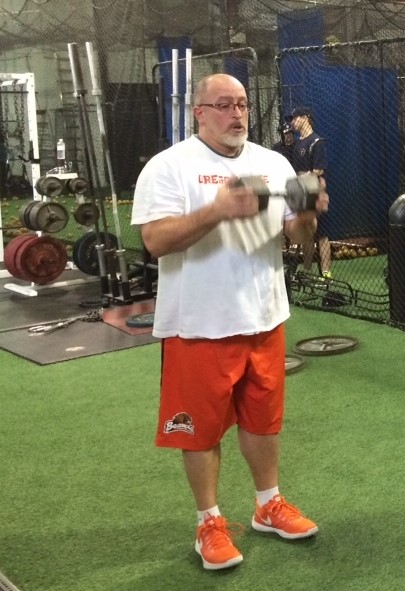Everyone knows that hockey is a game of speed- those first to the puck definitely have the upper hand. But what most athletes neglect in training, is the importance of functional rotational strength. In hockey, a strong, flexible core region (abdominal and low back) will aid in a powerful stride as well as balance and stability on the ice, protect from injury, as well as improve shot performance. Part one of this article focuses on unique exercises that will strengthen the core area of the hockey player making him or her a force to be reckoned with on the ice.
Exercise 1 – The Tornado:
The Tornado is an excellent movement that targets not only the core, but also the entire shoulder girdle. The unique function of this exercise lies in the range of motion- the athlete must constantly contract the core muscles, eliminating any resting phase of the movement.
Execution: Have a barbell loaded on one side only, with the empty side placed into the corner of the wall or corner of the power rack. With feet slightly bent and shoulder-width apart, lift loaded side to chest height with arms bent to begin the movement. Lift barbell overhead and proceed to turn upper body to left side, while lowering the barbell to the left side with arms slightly bent. Hold pause and contract. Raise barbell to starting position above head and proceed with right side.
Repetitions: 10-12
Sets: 2-3.
Be sure to use a weight that enables you to “feel” the exercise- form is essential. A gradual progression of added weight or extra reps (only if form is impeccable) will provide extra challenge to the player.
Exercise 2) – Russian Twists with medicine ball
The Russian twist is another movement that works the core region with direct resistance (medicine ball), as well through the athlete trying to “stabilize” the body through body balance.
Execution: Simply sit on the ground with the upper body arched and slightly leaning back (approximately 45 degree angle) while simultaneously lifting the feet in the air. The knees are kept bent throughout the exercise. Now, while grasping the medicine ball at one side of the body, begin lifting the ball off the ground and twisting the arms and lower abdominal region to the other side and hit the ground with the ball. Don’t relax the ball as it makes contact with the ground, but simply continue the exercise to the other side, continuing to make brief contact with the ground and twisting to the other side.
Repetitions: 20-30 to begin
Sets: 2-3
If the exercise becomes too easy for the athlete, simply add more repetitions, go for time, or even use a slightly heavier medicine ball. Remember to focus on form, and progress will follow!
Exercise 3) – Partner Assisted Static Pushes
This is a simple, yet effective exercise for training the rotational core muscles of the abdominal region (internal and external obliques). The only drawback to this exercise is that at least two people are needed to perform it.
Execution: Simply have two athletes facing one another with legs shoulder width apart. While the working athlete holds their arms straight out in front and hands clasped together, the partner will simply add resistance by slightly pushing against the hands of the athlete. The working athlete will then try to keep their arms straight out in front of themselves, by “pushing” against their partner. This exercise targets the oblique regions of the athlete, by forcing them to use their core region (abdominals and lower back musculature) to remain in position.
Repetitions: 12-15 reps or go for a set time
Sets: 2-3 (change sides, and push from the other direction)
Remember not to push too hard against the working athlete, but just enough to let them feel their core area being worked. Again, add repetitions to the exercise or time for added progression.
There you have three great exercises that can be incorporated into an abdominal circuit. Choose 1-2 of these to begin, but remember, form over weight being used is the utmost concern- Please, leave your ego at the door! Enjoy.
PLEASE CALL US NOW FOR OUR SUMMER CAMP- only 17 spots left!
visit http://sst.training/highperformancehockey.php
NOW!!!






